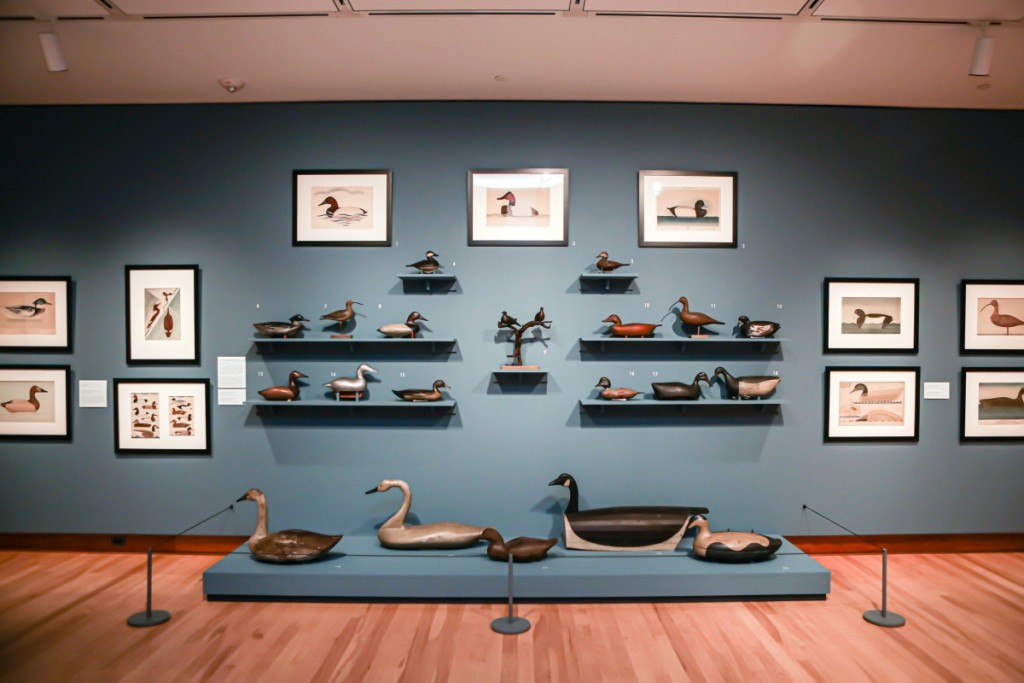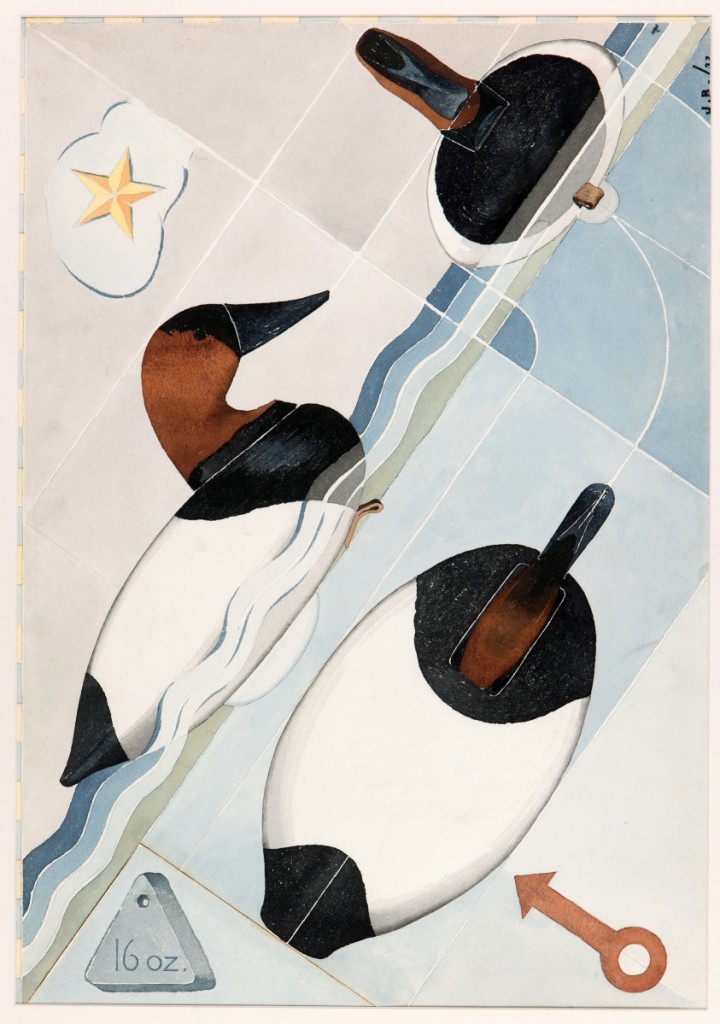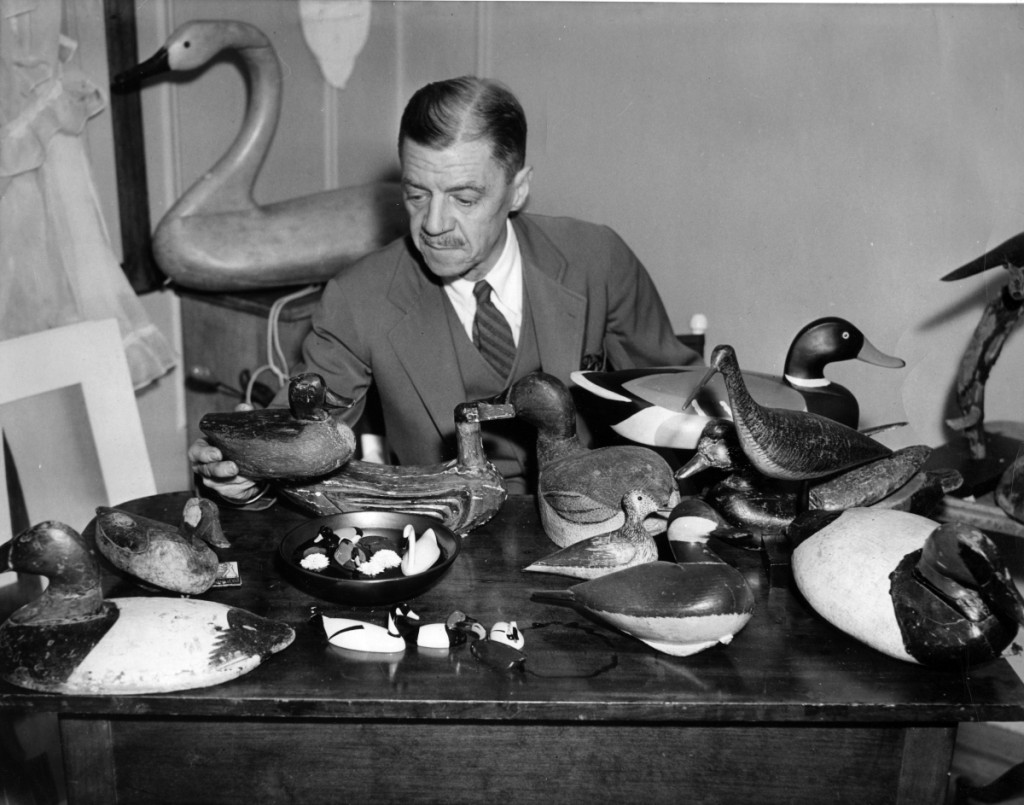Q&A: Kory Rogers
This interview appeared in the October 18, 2019 issue of Antiques and the Arts Weekly
As duck hunting season gets underway, there are a few decoys - long retired from their duties - that won't be joining their brethren out on the water. And that's fine, because their owner wasn't much of a hunter, either, more a missionary. An exhibition at the Shelburne Museum dives into the heart and soul of decoy collecting, to the man who is credited as the collecting field's "Godfather" - none other than Joel Barber. The Shelburne has owned Barber's collection, considered the first major public collection of decoys amassed as artwork, since the 1950s. Curator Kory Rogers tackles Barber's life work in the temporary exhibition "Joel Barber & the Modern Decoy," on view through January 12. The exhibition features decoys, drawings, historical photographs and watercolors, and we sat down with Rogers to sort through it.
How did the exhibition come to be?
I call it productive procrastination. Whenever I got bored working on a project, I would dig deeper into Joel Barber's papers. When I did that, I would find connections that nobody had ever made in the 60 or 70 years that we have had the collection. It was similar to a puzzle. I first started working on him in 2014 when we were renovating our Dorset House galleries, which houses our permanent collection of decoys. The first thing I realized is that - sure, there are bigger collections and those of similar quality - but what really distinguished Shelburne's decoys was Joel Barber's collection, it was the nucleus. It's the first collection of record.
Why is Joel Barber notable?
Joel Barber was a pioneer in many ways. He's considered to be the first collector who saw decoys as works of art. He would often refer to them as a polychrome floating sculpture. He was the first to write a book dedicated to the history of decoys, the men who made them and how they were used. He's considered to be the father of modern American decoy collecting.
Who were his contemporaries? Was he completely alone in the pursuit?
A lot of people did it afterwards. Joel Barber was instrumental in raising the public profile of duck decoys, through contests and publicity, but also through his 1934 book, Wild Fowl Decoys. That became the primer for all people that came after him. After 85 years, it still holds up to a certain degree, but others have added to the field since, including Bill Mackey, Dr George Ross Starr Jr and Adele Earnest.

Display of various decoys in the gallery at Shelburne Museum where the exhibition "Joel Barber & the Modern Decoy" is on view through January 12, 2020.
Image courtesy Shelburne Museum.
What carvers did he know personally?
He was good friends with Charles "Shang" Wheeler; they became acquainted with each other when Wheeler won the 1923 Howell's Point Anti-Dusker's Society decoy competition in Bellport, Long Island. It was the very first decoy show ever held and it was put on to raise awareness of the illegal activity of dusk hunting, or shooting birds after sundown as they come in for the night. Barber knew people like Bob McGaw, a carver from Maryland. He met Joe Lincoln. He seems to have avoided Elmer Crowell for unspecified reasons. I think it was because at that time, Crowell was doing decorative birds as opposed to hunting birds. Although he was not a hunter himself, Joel was more interested in working decoys.
How would he go about collecting at a time when there wasn't really a secondary market for these things? Carvers? Hunters?
It was any and all. Joel Barber discovers his first decoy by accident in 1918, a nondescript merganser hen in a sailing loft off the south shore of Long Island. He was fascinated by its form and abstract plumage. That's the first decoy recorded to be collected as a work of art. Then he starts looking up and down the Atlantic Flyway, from Nova Scotia to North Carolina. He was looking in junk shops and building a network of carvers. He wasn't above taking something that he considered abandoned property. He always half joked that not all of his decoys had clear titles. He would source these things through a network. Through the carvers themselves, through people who were starting to collect them - he would make a lot of friends, he was an extremely affable man. In the later part of his life, he goes up North and starts collecting in Michigan and the Great Lakes. If he had lived longer, I think he would have gone out to the West Coast.
In what ways would he promote the field?
He went on television, radio shows and was featured in numerous magazines and newspapers articles. In 1932, Fortune magazine did a spread on his collection. He helped organize exhibitions in galleries and participated in museum exhibitions. Any outlet he could find, he would take. He designed store window displays, too. He curated exhibitions at the headquarters of Abercrombie and Fitch on Madison Avenue in 1931 and 1932.

From left, Chauncey Wheeler blue bill decoy with Henry Kilpatrick decoy.
Image courtesy Shelburne Museum.
What is the history of the collection? How did it come to be housed at the Shelburne?
When Joel Barber died in 1952, he didn't leave any instructions to his sons as to what they should do. They wanted to honor him and make it public because they recognized that he created the first decoy museum, the "Shanty Museum of Old Decoys," in an old chicken coop on his property in Wilton, Conn. So artist Ogden Pleissner helped orchestrate a deal where Shelburne Museum's founder Electra Havemeyer Webb's three sons purchased the collection as a present for their mother in 1952.
Was decoy collecting fully developed by the 1950s?
Barber had laid the foundation and it was big business at that time. People saw it as a uniquely American invention. There was a lot of interest in it. The prices started to climb and they continue to do so today.
What is the most notable work in the collection?
There are certain things like the Sam Barnes swan, the Lee Dudley ruddy duck. But for me, it's the actual decoys that he designed himself.

"Canvasbacks" by Joel D. Barber, 1932. Watercolor on paper, 25-1/4 by 17-5/8 inches. Collection of Shelburne Museum.
Image courtesy Shelburne Museum.
The "Modern Decoys."
As a modernist architect and collector, he decided - after studying them for so long - that he knew what was going to make the perfect decoy. They're kind of Frankenducks, combining pieces from different decoys from different areas, and they came out kind of clunky. He wasn't a hunter so he didn't know how they would perform - they had a tendency to list and capsize. But he started to refine them and decided he would make them decorative. He experimented with funky abstract designs, inspired by World War I and World War II "Dazzle" Navy patterns. Those are the things closest to him and his aesthetic. We have eight of them in the new show, and probably 30 of them in the regular galleries.
Of the 300 examples in the Barber collection at the Shelburne, how many decoys are in your new exhibition, and why did you select those?
There's about 30 in this exhibition, I selected them because I wanted to show people that Joel Barber was using his decoy collection as the basis of the watercolor illustrations in his book. It's a bit like I-Spy, you can see the watercolor from his book and then see the actual decoy, but in the same section you can see images of where he used them in window displays, exhibitions, etc.
Why did he draw instead of photograph?
It was a mix, he included photography, but because he was an architect and trained draftsman, he would do measured line drawings of the decoys so he could reproduce them. But he also produced these wonderful idiosyncratic watercolors. It's all very artful. The water, especially. He also did orthographic depictions, where he shows the bird from three sides, and that was his way of capturing the birds in this almost cubist, fractured way. And I like that none of them are similar, the only thing consistent about Joel Barber was his inconsistency.

"Joel Barber with Decoys," unidentified makers, date unknown. Gelatin silver print, 8 by 10 inches. Joel D. Barber Papers. MS422.2.
Image courtesy Shelburne Museum.
What do the documents on exhibit reveal?
How he would take these objects made in the Nineteenth and early Twentieth Century, and when he was drawing them - he was mostly drawing for publication purposes or fun - he was overlaying this modernist aesthetic, an Art Deco style, and you can see how he applied it to his graphic design, like the cover of the book. He was putting a modern spin on things people thought antiquated at the time. It wasn't only his own taste, but he was trying to make these things palatable to contemporary audiences and potential collectors.
Are there any stories about the decoys that you learned about while going through everything?
A couple of years ago I was between the Dorset House and this exhibition, and I was approached by noted carver Gary Starr, his father was Dr George Ross Starr Jr, and he said his father had a recording of Barber. So we listened and digitized it. Barber knew the end was coming and he was working in earnest on his second book, which was never finished, but in this recording he talks about how he acquired the Barnes swan decoy. He talks about approaching the owner Bennett Keen about purchasing it. Keen said he wasn't ready to part with it, so Barber said he wanted to draw it for the book he was planning. Barber was in the middle of drawing it and Mr Keen's son came up and asked why he was drawing the swan. When he heard this, the son convinced his father to sell it. Just by looking at the swan, you can see a break and a mend in the neck. In the recording, Barber explains that Mr. Keen's friend liked to bet on the ponies at the local race track, and he would come by every time he was on his way to the races and turn the swan around several times by its neck for good luck. Several wonderful and fascinating stories were captured in that recording, many of which informed much of the exhibition.
Being a luminary, Barber must have some folklore attached to him?
One of the things that comes along is he was a very Victorian man, always wearing a suit and tie, he spoke in this mannered way of talking, and yet he was able to converse with people who were longshoreman, boat captains. And the fact that he wasn't a hunter and not interested in the birds as hunting devices, it built up this whole idea that he was the first scholar.
What about that second book?
I'd like to publish something based on his unfinished second book, but that will take a while. He died working on the book at his workbench. He was also a poet who wrote from the decoy's perspective - lamenting the fact that they weren't out being shot over and now they sit on museum shelves. He was a missionary, out to proselytize about decoys.
-Greg Smith
Credits
Used with Permission. Q&A: Kory Rogers. Antiques and the Arts Weekly. October 8, 2019. View Article on Antiques and the Arts Weekly >